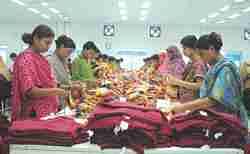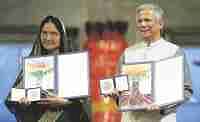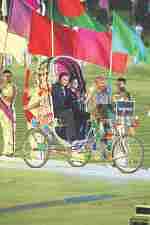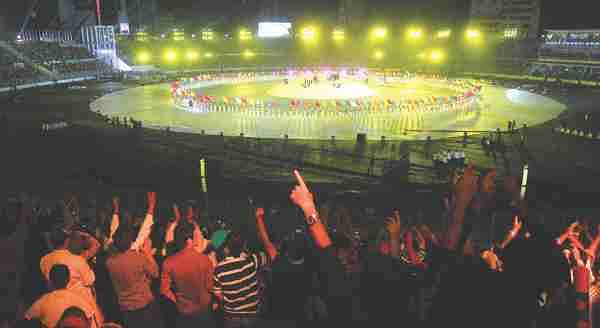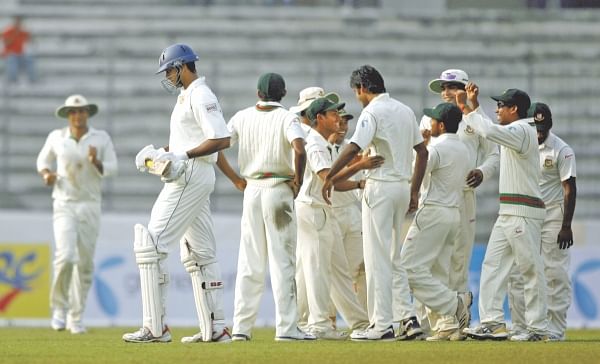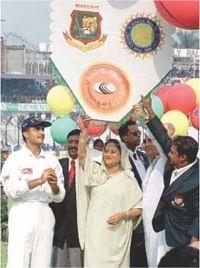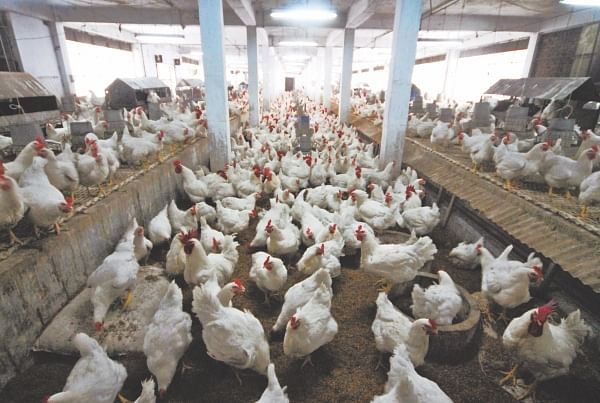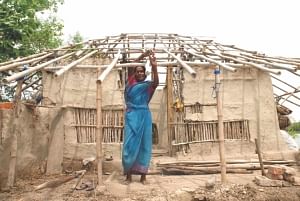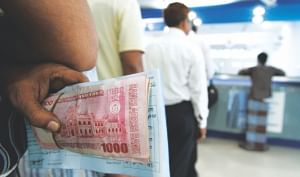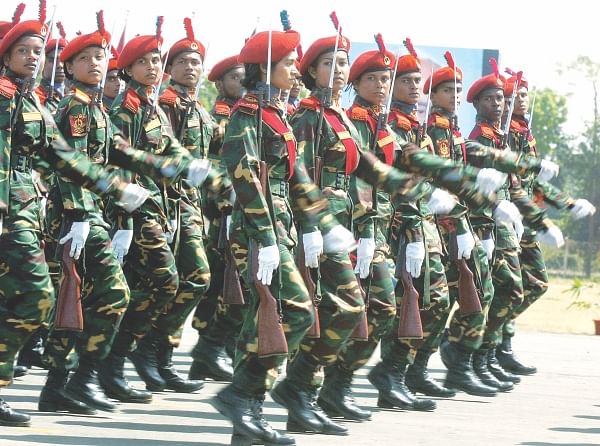| Home - Back Issues - The Team - Contact Us |
 |
| Volume 10 |Issue 47 | December 16, 2011 | |
|
|
Cover Story 2: Migrant Workers With Love, From Abroad
Since the mid 1970s, a large number of Bangladeshis have migrated overseas for both short-term and long-term employment. More than 6.7 million workers have migrated to over 140 countries in the world, but the primary destinations for Bangladeshi migrants have been the Arab Gulf States. The remittances of migrants – which now constitute the single largest source of foreign exchange earnings – have played an increasingly vital role in the national economy of Bangladesh. In 2011 alone, official remittances to Bangladesh amounted to $11.5 billion, which represent about 13 percent of the country's gross domestic product (GDP). Remittances were more than nine times the level of foreign direct investment flows into the country and also about four times more than the total foreign aid received. There is no doubt that Bangladeshi migrant workers are indispensable to our economy. However, the state should ensure that the rights of its citizens abroad, especially of less skilled workers, is not violated. It should play a more proactive role in countering the abuse, violence and exploitation faced by the migrants when they are abroad, earning foreign currency often at high costs to themselves. Garments The New Era of RMG Exports
Bangladesh is the world's second largest apparel exporter with a $ 20 billion industry. Our share in global garment exports is 4.5 percent. The Export Promotion Bureau (EPB) statistics shows that the contribution of readymade garment products to national export has increased by 1.02 percent in fiscal year 2010-11. In fiscal year 2010-11, the contribution of RMG (woven and knitwear) to national export was 78.14 percent or $17.91 billion while it was 77.12 percent or $12.50 billion in fiscal year 2009-10. The European Union's new rules under the Generalised System of Preferences (GSP) at the beginning of the year have given new horizons of optimism to the entrepreneurs. Implementation of the new rules will hopefully ensure duty and quota free exports for all of our RMG products into the EU market. Moreover, experts are also hoping that India's declaration of duty waiver on imports of 45 garment items and a silk fabrics item will be a major boost to the industry. The positive trend persists as a lot of orders for basic garments are shifting to Bangladesh from other countries. Bangabandhu Bridge The Bridge of Dreams It serves as a crucial link between the eastern and western parts of Bangladesh, facilitating the movement of people and goods, trade and transmission of electricity and natural gas between different parts of the country. Prior to the construction of the Bangabandhu Bridge, also known as the Jamuna Multi-purpose Bridge, the river could only be crossed by ferries, launches and boats, which was neither an efficient nor a cost-effective mode of transportation for individuals or businesses. Now, more than 30 million people are connected to the country's transport network. Bangabandhu Bridge, constructed over the Jamuna River in 1998, is the 11th longest bridge in the world and the 6th longest bridge in South Asia. The bridge, 4.8 kilometres long and 18.5 meter wide, is the most elaborate and expensive infrastructure in Bangladesh, costing US$754 million, funded jointly by IDA, Asian Development Bank and the Japanese Overseas Economic Cooperation Fund (currently Japan Bank for International Cooperation).
Nobel Peace Prize The Highest International Accolade The Nobel Peace Prize is, in Alfred Nobel's words, awarded to those who “….Shall have done the most or the best work for fraternity between nations, for the abolition or reduction of standing armies and for the holding and promotion of peace congresses.”
The first Banglad-eshi to receive this highly coveted honour is Dr Muhammad Yunus, who has lifted millions out of poverty with his concept of micro-lending and he shares this award with Grameen Bank, the micro finance organisation through which he has accomplished this tremendous feat. Dr Yunus was born in Chittagong in 1940 and studied at Dhaka University. He then received a Fulbright scholarship and went off to study at Vanderbilt University in the United States. Shortly after he received his Ph.D in economics from this university in 1969, he returned to Bangladesh to head the economics department at Chittagong University. It was here that he developed the concepts of microfinance and microcredit. In 1983, Yunus established Grameen Bank. He believed that credit is a fundamental human right and through Grameen Bank, he set out to help elevate the poor from their poverty by offering them loans without collateral on terms suitable to them. He also taught them a few basic financial principles so they could use this money wisely. From providing small personal loans to destitute crafts people in the 70's, Yunus lead Grameen Bank to the frontline of the world movement toward eliminating poverty through micro-lending. More than a hundred countries worldwide now host replicas of the Grameen Bank model. Yunus is also the recipient of numerous international awards for his ideas and endeavours. World Cup Hosting Moments to Remember We do not remember days; we remember moments
Looking back at 2011, Bangladesh offered far more to forget than to remember; in moments or in days. But if collective memories can be stretched, they will reveal that despite how the year threatens to end, it did in fact begin in high spirits. Twelve months ago, life as we knew it was willing to take a back seat to the event that would put us on a coveted international platform. And twelve months ago, every Bangladeshi was willing to change his life to enable 46 days of cricketing history. For a country with searing sporting passions but diluted global presence, the ICC Cricket World Cup on home turf was an event worth being glad-you-were-alive for. To be allowed the rare respite of showcasing our hospitality to an international audience in place of floods, poverty and corruption was indeed a crowning moment, and not just for 2011. Over the course of six weeks, Bangladesh put her best face forward in terms of mobilising infrastructural changes, displaying high standard organisational capacities, creating a welcoming and electrifying atmosphere and most importantly in producing an opening ceremony which was so good that Siddhart Monga from Cricinfo wrote that “nothing could have been more welcome than the sheer enthusiasm and passion with which Bangladesh had put together its show.” He went on to revel in the fact that there were so many people outside the stadium who were cheering despite the fact that “…there was obviously no alcohol to keep them going, but they danced and made merry, choreographing their own moves.” And that encompasses us in a nutshell as far as the World Cup is concerned. Because despite the delirium provided by the victories over England, Ireland and the Netherlands, this was also a World Cup marred by ridiculous lows, most notably the 58 all out against the West Indies which saw a collective expression of frustration so great that it culminated in the shameful stoning of the West Indies team bus. But even as we got the 'kiss-teeth' of disapproval from Chris Gayle, the World Cup was generally one to revel in. Three victories out of six, and a fair number of high-profile games to go with the opening ceremony and the opening match. So, to end where we began, it is not days that we remember, it is moments. And no matter the height of political frustration or economic adversity; no matter even the recent bout of cricketing incompetence, World Cup 2011 is our moment to remember. The writer is a senior subeditor of The Daily Star.
Test Status
Elite, but miles to go Mohammad Isam With every Habibul Bashar square cut and the deft little touches of Aminul Islam, hope swelled at the Bangabandhu National Stadium on that bright November day in 2000. Bangladesh was playing its first full day of Test cricket in front of a packed crowd that had its share of beady-eyed cynics. Saber Hossain Chowdhury, the then president of the Bangladesh Cricket Board, was nervous but it didn't show. He was pinning his vast ambitions on cricketers now as all this time, the focus was on cricket's popularity and taking baby steps for its infrastructure.
But even the most ardent enthusiast of Bangladesh cricket would admit that it wasn't a team ready to take on the world. First-class cricket had just taken off and it was quite clear, through disappointing foreign tours, that Bangladesh had a lot of catching up left. In that first match, however, they showed enough glimpses of talent to prove that they belong. Bangladesh's inaugural test against India ended up being a “Bulbul show”. The former captain of the national team scored 145, helping Bangladesh score a very promising 400 in the first innings. Most surprisingly, Bangladesh played 153 overs during that first inning, something the current team have not been able to repeat in the last decade. Bulbul stayed resolute at one end after Bashar's promising innings, making small but vital partnerships with Akram Khan and Khaled Mashud, who soon became known as the tireless foot-soldier. After Bulbul's effort, Bangladesh continued to impress as they bowled out India for 429 with captain Naimur Rahman taking 6-132 with his off-spin. But after that, Bangladesh came crashing back to reality through the now-familiar batting collapse. The second innings folded for 91, the paltry target chased down by India. The second innings has come to signify Bangladesh in Test cricket. Except for giving world cricket a few good innings, some hearty performers and one world-class, all-rounder in Shakib Al Hasan, Test cricket hasn't seen the best of Bangladesh just as yet. The writer is Senior Sports Reporter, The Daily Star. SMEs Small and Powerful Immediately after Bangladesh was born the then US Foreign Secretary Henry Kissinger called our country a 'bottomless basket case', but that scenario has changed in the past 40 years; Bangladesh is now one of the 'eleven fastest growing economies of the world'. In other words, we have a growing population that is rising above their economic standards. In addition our tertiary sector is the fastest growing, and we are earning a good sum of money by exporting RMGs (Ready-made garments), shrimp and textiles. A revolution has long begun where the power of the small has reined to bring about economic stability through market based growth. The point being that the economy to develop needs to build on its capitals to invest in commercial development. However, since we are agriculture- based and most of our farmers are limited in scope and resources, it is not feasible to invest in bulk; that is why SMEs (Small Medium Enterprise) are so important. An SME does not have a specific definition but rather is characterised by enterprises employing around 50 to 99 workers and/or having a fixed capital investment between Tk 100 and 300 million. The industrial structure of Bangladesh comprises of 90 percent SMEs namely operating in cottage industries which are household-based industrial units operated mainly with family labour. In places like Rangpur, Bogura, Jessore and other peripheral locations of the country Small and Medium Enterprises are booming. Being more labour-intensive and because of the likelihood that SME owners are less wealthy than the owners of large firms, the smaller enterprises are more equitable in distributing the income that they generate. Poultry farming and seasonal vegetable production have been some of the most successful sectors in agriculture that SMEs have flourished. They are also more likely to operate in towns and villages, as well as in the less developed regions, which contribute to a wider spread of the benefits of development and to alleviate the pressure of rapid urbanisation. Given the relatively low skill and technology content and the geographically dispersed nature of smaller enterprises, the incidence of female employment is higher in this field. This renders these enterprises to be more supportive of poverty reducing development strategies. All over the country SMEs are being developed; NGOs and various development agencies and projects have been working to introduce the rural poor to SMEs and they do so with the collaboration of the government. SMEs currently contribute to 25 percent of the country's GDP (Gross Domestic Product), and this percentage is on the rise.
SAARC SAARC: Brainchild of Bangladesh It was Bangladesh that made the first concrete proposal for establishing a regional platform for the countries in South Asia. The late President of Bangladesh, Ziaur Rahman, initiated the official process of creating the South Asian Association for Regional Cooperation (SAARC) May 2, 1980. Although the idea of regional cooperation had been discussed previously in international conferences in the 1940s and 1950s by some of the current member countries, it was never put on the table in a serious way for a variety of complex reasons. In the late 1970s and early 80s, Ziaur Rahman prompted the South Asian countries to evaluate and accept the need to establish a forum to foster self-reliance and collective development of the member states. The seven founding members were: Bangladesh, Bhutan, India, the Maldives, Nepal, Pakistan, and Sri Lanka. Thirty-one years since its inception, SAARC continues to be the only official regional platform between the countries of this region. Despite its many limitations, it offers the promise – and as of now, the sole promise – of a more collective future for the region.
ICT On the Road to Realising a Digital Nation
As much as a lot of skeptism is associated with the words 'Digital Bangladesh' we have achieved quite a bit to want to aspire big in the ICT sector. To highlight quite a few achievements, Bangladesh has faced a change that can be called a 'huge digital step forward' by launching the first Bangladesh-assembled laptop “Doel”. The unique feature of Doel netbooks and laptops lies in its operating system (OS). The OS is designed in both Bangla and English. As computer literacy in the rural areas is low due to incompetence in English, the OS is designed in Bangla. Moreover, it can always be changed to English, when needed. The noble intension in launching Doel, however, lies in the fact that it is available at a very low price so that the poorer majority of the country may be able to access technology at an affordable price. Moreover, the placement of Sixty-four district e-service centers with the establishment of four thousand, five hundred and one union information service centers (UISCs) across the country is indeed a digital leap forward. These E-centers are basically there to provide information and technological support to anyone who seeks it and their location all over the country highlights the fact that technology is reaching every doorstep in Bangladesh. Bangladesh has been ranked among the top 30 IT outsourcing destinations according to the Garnter's ranking. This goes on to show that Bangladesh is quite competitive and capable of great potential in terms of ICT based development. The 66th United Nations General Assembly awarded Prime Minister Sheikh Hasina 'South South Award' for outstanding contribution of her Government to the development of women and children for her innovative idea to use the information and communication technology for progress of the health of women and children. Bangladesh has recently hosted eAsia 2011 which is Asia's premier ICT event themed, “Realizing Digital Nation.” The conference and exhibition featured 90 foreign speakers from 30 countries and 70 local speakers. Disaster Preparedness Through Thick and Thin
There is no denying that Bangladesh is a disaster-prone country. Even before its birth as an independent country, Bangladesh faced many famines, earthquakes, great floods and cyclones. However, we are a nation that has lived and survived with a commendable ability to fight disasters. Our greatest casualties date back to the cyclone in 1991 when 200,000 people lost their lives. The great flood of 1988 killed 5,000 people and damaged properties worth US$ 2.2 billion. About 1.25 million houses were destroyed, eight million people were rendered homeless, and 45 million people were directly affected. Nowadays, the effects of such floods have been reduced significantly. The great flood of 2007 resulted in the death of about 500 persons. No type of casualty is desired but the fact that it could be reduced to such a significantly small number is an achievement itself. Early warning systems, cyclone shelters and government policies have helped to greatly reduce the number of fatalities. The Disaster Management Act and Action Plan and its 10-year Climate Change Strategy and Action Plan have been effective in bringing down the effects of natural disasters. It has also formed a Climate Change Cell which seeks to build capacity across government institutions and bodies and the civil society. NGOs have also been actively involved. The flood risk has also been reduced, as the poor are now better able to tackle poverty with increased assets and raised homesteads on plinths. In this way resilience to cope with climate change is increased, whether it is in the form of predictable flooding or less predictable natural disasters. Since cyclones Sidr in 2008and Aila in 2009, family shelter constructions have been built in Bangladesh. These structures are not only there to provide a safe place to stay but also to provide the provisions and facilities to rehabilitate those affected by disasters. Such shelters are used both as virtual information centres and community based learning points. Private Banks Money Multipilers
Pre-Liberation, there were only two private commercial banks under Bengali ownership operating in the then East Pakistan. Forty years after Liberation, the number has increased to 30. The Banking Sector of Bangladesh is perhaps the only service sector that has not only proliferated in terms of numbers but also experience huge reforms. After the initial waves of nationalisation in the 70s, the 80s witnessed privatisation along with a shift in banks' portfolio from investment in jute to the RMG sector. The first generation private banks emerged with management teams, who brought their expertise from the century old foreign banks and the added- advantage of having the knowledge of the local market. The 90s along with the introduction of advanced banking technology marked the era of the second generation private commercial banks. The concept of retail banking developed concurrently. However, access to capital was given a boost, during the same decade by the phenomenal growth of microfinance institutions. The sudden boom in the industry called for stricter regulations in the banking sector, and Bangladesh Bank, the central bank of the country, raised the capital adequacy requirements. Yet the late nineties and early twenty first century witnessed the influx of the third generation private banks. Today, four state-owned commercial banks, five government owned specialized banks, 30 domestic private banks, nine foreign banks and 29 non-bank financial institutions operates in Bangladesh along with 298 licensed micro-credit organisations. According to International Monetary Fund data, the number of ATMs (automated teller machines) per 1,000 km2 in 2004 was 1.03 increasing to 16.46 in 2010. This manifold increase is evident of the proliferation in the banking sector and its embrace of modern technology. Women at Workplace
The Bangladeshi Woman As an independent country, Bangladesh's biggest achievement has been the initiatives it has taken to empower women. Up until a few decades ago, it was unthinkable for most women in this country to be educated, much less have a career. Now, slowly but surely a number of substantial gains have been seen in women's status over the past few decades. School enrollment of girls exceeds that of boys, the maternal mortality rate has fallen, the gender differences in the survival of children have lessened and women's participation in the workforce has doubled since 1995. In response to demands made by different internal and external pressure groups, the participation of women in all sectors of the economy has increased dramatically. In the past, due to social and cultural barriers, women were confined to traditional gender roles in industries such as food and beverage, beauty care, health, education, tailoring, wholesale and retail apparel trade. Today, women hold positions in the previously male dominated sectors, such as top-level management posts in both public and private sector enterprises. Women are also members of the parliament and sit in the most important policy making bodies of the country – two of the most powerful politicians in this country happen to be women. Women are also entrepreneurs and own their businesses. They are managers of cold storage, shipping lines, garments industries, advertising firms, travel agencies; they are engineers, doctors, lawyers, architects, bankers, country directors of some of the most prominent NGOs of the country. What's more, women are now visible in the police force and even the army. Women living in the rural areas of Bangladesh also no longer just sit at home. They are either self-employed or employed in family-based enterprises, both agricultural and non-agricultural. These include homestead agriculture, livestock and poultry rearing, fish farming, nursery and tree plantation, tool making, kantha sewing, fishnet making, food processing, tailoring, rice processing, and working in factories in rural areas. Their income has been regular and, although not always acknowledged, has been a helpful contribution to their families. Due to educational barriers, many women in Bangladesh are employed in low-level jobs in the Agriculture, Forest and Fishery, and Ready-made- garments sectors. Some hold clerical jobs in offices while others work as day labourers and domestic workers. Although women are becoming active participants in the workforce, their percentage in these sectors is low compared to other South Asian countries. Women make up about 26 percent of the labour force in Bangladesh, which is among the lowest in the world. However, the situation is gradually improving as more women are being educated and understand that the Constitution gives them equal rights to their male counterparts. Today, Bangladeshi women have a voice; they are strong and confident and are paving a path to progress for their future generations.
Copyright
(R) thedailystar.net 2011 |

